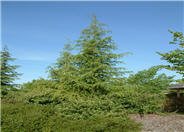
Common name:Deodar Cedar
Botanical name:Cedrus deodara
This coniferous evergreen forms a large pyramid with graceful, arching branches. Needles are a silvery grey-green to yellow-green. Give plenty of room as tis tree can grow to be 35 to 45 feet tall and 25 feet wide, and with age, even larger. Cedars have lovely cones, emerging bluish when young and aging a reddish brown.
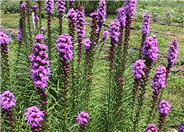
Common name:Kobold Gayfeather or Blazing Star
Botanical name:Liatris spicata 'Kobold'
A selection of L. spicata, 'Kobold' is a favorite of the florist trade, loved for its brilliant magenta to violet flower spires, erect habit, and long bloom, mid to late summer. It provides valuable vertical interest in a perennial border, and it also blends well with ornamental grasses. A great cut flower, it also attracts butterflies and hummingbirds. It grows about 18 to 30 inches tall and 8 to 12 inches wide.
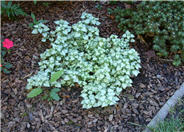
Common name:Beacon Silver Dead Nettle
Botanical name:Lamium maculatum 'Beacon Silver '
'Beacon Silver' is another lamium cultivar, with silver-white leaves and green margins. The margin between the white and green areas seems more crisp than in 'White Nancy.' Grows about 6 inches tall and 18 to 24 inches wide by underground runners. Has small pink flowers in late spring to early summer. A great groundcover for partial shady to shady areas.
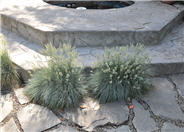
Common name:Elijah Blue Fescue
Botanical name:Festuca cinerea 'Elijah Blue'
The icy-blue coloration of this little grass makes it a stand-out in the garden. Its evergreen, clumping habit make it well suited for edging borders, mass planting, or ground cover. Grows in full sun to part shade. Generally under 12 inches, even in flower. Soft tufts of greenish white flowers emerge in early summer and turn tawny by summers end. Excellent for parkstrips.
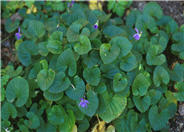
Common name:Sweet Violet, English Violet
Botanical name:Viola odorata
Sweet violets are charming additions to the shade garden. heart-shaped leaves are a deep, glossy green. Violet spring flowers are small, nodding, and fragrant. Spreads by seeds; some think it invasive, but I enjoy seeing its perky self at the shady fringes of the lawn. My dog Mieke loved to lay on them, and they tolerated her quite well. Grows 2 to 3 inches tall and 12 or more inches wide.
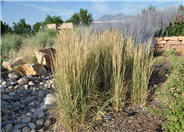
Common name:Overdam Reed Grass
Botanical name:Calamagrostis x acutiflora 'Overdam'
Overdam is a wonderful ornamental grass for small spaces. It has an upright and slightly arching habit, with clumps 18 to 24 inches tall, topped by oaty plumes up to 4 feet. Blades are green with a cream to yellow margin. Plumes are oat-like, emerging reddish brown in late spring, and turning golden to buff in the fall.
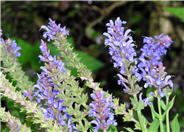
Common name:May Night Meadow Sage
Botanical name:Salvia nemorosa 'May Night'
An outstanding variety of Meadow sage, May Night has a compact growing habit, and profuse deep-purple flower spikes. The heaviest flush of flowers occurs in May, but it blooms off and on all summer. Deadheading encourages heavier re-blooming (see Guide). Deer and rabbit resistant. A wonderful cut flower. Grows 15 to 18 inches tall and 18 inches wide. Can be seen in the Washington Square Demonstration Garden.
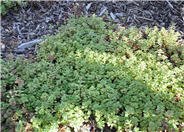
Common name:Moss Sedum
Botanical name:Sedum acre
A perfect sedum for rock gardens and borders, Goldmoss sedum forms a carpet of soft green that becomes completely engulfed with yellow flowers in summer. Foliage turns a beautiful shade of red during cold months. Use among stepping stones, along a garden path, or in a parkstrip. Also nice in containers. Grows about 3 inches tall and spreads about 10 inches wide. It is a little brittle, and so is best with only light foot traffic.
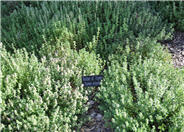
Common name:Mother-of-Thyme
Botanical name:Thymus serpyllum
Mother-of-thyme is a woody based perennial which is primarily used as a ground cover. Numerous, thin, somewhat woody stems form a low mat (2 to 3 inches tall and 12 or so inches across) with tiny, rounded, glossy blue-green leaves. Leaves are aromatic, though usually not considered to be of culinary quality. Clusters of tiny, tubular, deep pink flowers appear in summer. Flowers are attractive to bees. There are many cultivars with a more dependably low habit; the species is a bit taller and so is best used at the sides of walks of paths, or to edge a sunny border.

Common name:Dwarf Alberta Spruce
Botanical name:Picea glauca 'Conica'
Dwarf Alberta Spruce is the quintessential cone-shaped evergreen. Slow growing to 6 to 8 feet tall and 4 to 5 feet wide (though I have seen some very old ones that are nearly 10 feet), it forms a dense, cone-ish evergreen statement in the landscape. Use as an accent, or to contrast more natural or informally-shaped plants. There are some named cultivars available, distinguished by needle length, height, and other characteristics.
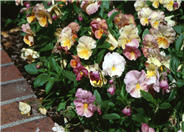
Common name:Pansy
Botanical name:Viola
Okay, so you might not think of pansies as a low-water plant, but given that they are typically planted in the fall or early spring, they manage on very little supplemental watering, at least until summer. So, used in those seasons, they may be well suited to a water-wise garden. They come in too many colors and combinations to mention. They are all relatively low-growing, and bloom when its cool. A wonderful companion to flowering cabbage and kale. Just don't put them out in the sun in the hot summer months and expect them to thrive.
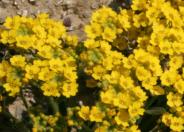
Common name:Mountain Alyssum
Botanical name:Alyssum montanum
Bright yellow flowers in early spring cover this perennial. Gray green foliage blends well with strong summer flowers. Grows 4 to 6 inches tall and spreads 15 inches. It is useful as a filler in a perennial border, along walkways, or trailing over walls and rocks. After flowering, cut back spent blooms to create a tidy appearance.
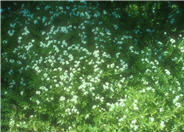
Common name:Sweet Woodruff
Botanical name:Galium odoratum
Sweet Woodruff is a charming, delicate-looking groundcover well suited to dry shade areas; but its appearance is deceiving as this is one tough little plant). Growing to about 2 to 4 inches in height, with single plants eventually spreading 12 to 18 inches, it slowly carpets shady spots with bright green, whorled leaves. Flowers occur in spring, are white, four-petaled, and fragrant. Stems are slightly sticky. Plants emit a strong odor of freshly mown hay when foliage is crushed or cut. Aromatic intensity of the foliage increases when dried, thus dried leaves are popularly used in sachets or potpourris. Plants have also been used commercially in perfumes. Leaves are sometimes used to flavor teas and cold fruit drinks. Leaves are also used to make May wine, a punch made from white wine flavored with woodruff.
| Designer: Kelly Pack | Kelly Home 31 |
Photographer: GardenSoft |
Water Saving Tip:
Replace turf with groundcovers, trees, and shrubs. If you have areas where no one uses the grass, patches that do not grow well, or a turf area too small to water without runoff, consider replacing the turf with water-efficient landscaping.
